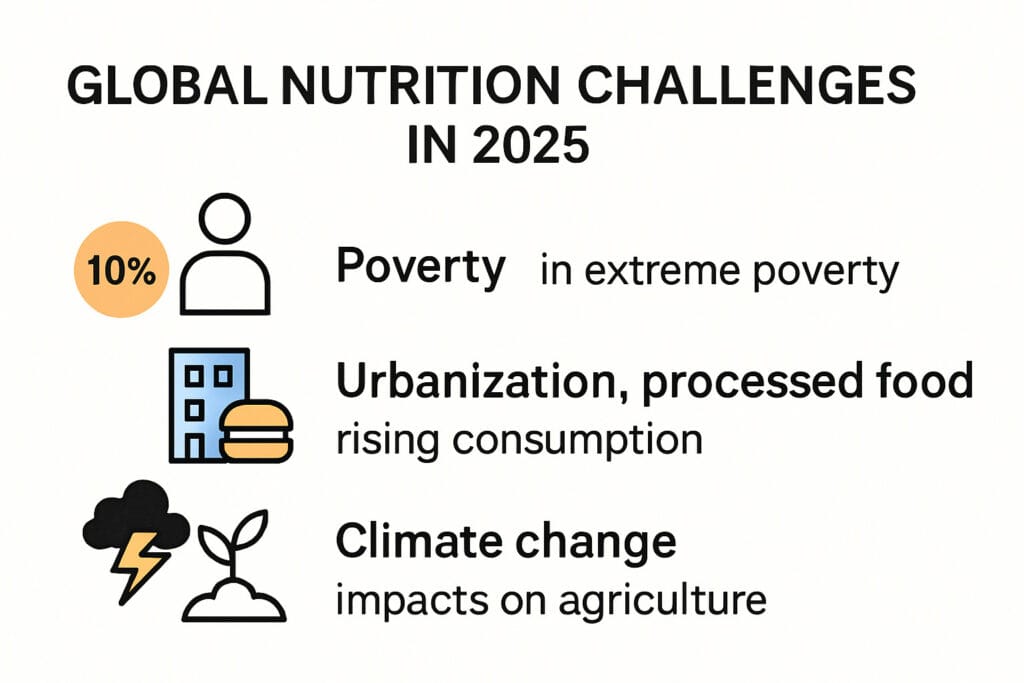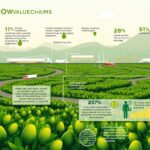We are approaching a critical juncture in global nutrition. More than 9 percent of the world’s population still lives in extreme poverty, directly impacting their daily nutrition. You might expect that rising technology and urban development would mean healthier diets for all. Strangely, the opposite is happening as processed food consumption climbs and climate change disrupts agriculture—setting the stage for a new kind of global malnutrition crisis.
Table of Contents
- Main Factors Driving Global Nutrition Challenges
- Economic And Policy Impacts On Nutrition Worldwide
- Innovative Strategies And Solutions For 2025
- Opportunities For Businesses And Investors In Nutrition
Quick Summary
| Takeaway | Explanation |
|---|---|
| Economic Inequality Impacts Nutrition | Limited financial resources restrict access to nutritionally adequate food, exacerbating malnutrition among low-income populations. |
| Urbanization Alters Dietary Patterns | As people move to urban areas, reliance on processed foods increases, leading to nutritional imbalances and rising obesity rates. |
| Climate Change Threatens Food Security | Changing environmental conditions disrupt agricultural productivity and food supply chains, compromising global nutrition availability. |
| Investment is Crucial for Nutrition | Significant financial commitments, estimated between USD 176 billion and USD 3,975 billion, are necessary to eradicate undernourishment by 2030. |
| Innovative Financing Can Support Nutrition | New strategies, like targeted taxes on unhealthy foods and integrating nutrition into universal health coverage, can create fiscal space for nutritional interventions. |

Main Factors Driving Global Nutrition Challenges
Global nutrition challenges stem from various economic, social, and environmental factors that fundamentally reshape how populations access, consume, and utilize food resources. Understanding these critical drivers becomes essential for developing comprehensive strategies to address widespread nutritional disparities.
Economic Inequality and Food Access
Economic disparities represent a primary catalyst in global nutrition challenges. Millions of people worldwide struggle with limited financial resources that restrict their ability to obtain nutritionally adequate food. World Bank research reveals that approximately 9.1% of the global population lives under extreme poverty conditions, directly impacting their nutritional intake.
The economic landscape creates stark nutritional inequalities where low-income populations face significantly higher risks of malnutrition. Households with limited financial means often resort to cheaper, less nutritionally dense food options, creating a cycle of poor dietary quality. These economic constraints force difficult choices between quantity and nutritional value, ultimately compromising individual and community health.
Urbanization and Dietary Transitions
Rapid urbanization fundamentally transforms nutritional patterns worldwide. As populations migrate from rural to urban environments, traditional dietary practices undergo significant shifts. Research from the National Center for Biotechnology Information highlights how urbanization contributes to the nutrition transition, characterized by increased consumption of processed foods high in fats and sugars.
Urban lifestyles introduce multiple nutritional challenges. Processed food becomes more accessible and affordable, while traditional cooking methods and locally sourced ingredients diminish. This dietary transformation leads to rising obesity rates, increased non-communicable diseases, and complex nutritional imbalances that impact public health systems.

Climate Change and Agricultural Disruption
Climate change emerges as a critical factor threatening global nutrition security. Changing environmental conditions directly impact agricultural productivity, food supply chains, and nutritional availability. The United Nations Climate Report indicates that agricultural systems face unprecedented challenges from extreme weather events, reduced crop yields, and shifting growing seasons.
These environmental disruptions create cascading effects on food production. Regions experiencing prolonged droughts, flooding, or temperature variations struggle to maintain consistent agricultural output. Smallholder farmers become particularly vulnerable, with reduced crop diversity and increased economic instability threatening local food systems.
Addressing global nutrition challenges requires a multifaceted approach that recognizes the interconnected nature of economic, social, and environmental factors. Policymakers, researchers, and global organizations must collaborate to develop adaptive strategies that enhance food security, promote nutritional education, and create resilient food systems capable of meeting diverse global nutritional needs.
By understanding these driving factors, stakeholders can design targeted interventions that address the root causes of nutritional inequalities and support sustainable, healthy food ecosystems worldwide.
To help clarify how each main factor uniquely impacts global nutrition, the following table summarizes their specific effects and examples:
| Main Factor | Key Effects on Nutrition | Example/Detail |
|---|---|---|
| Economic Inequality and Food Access | Limits access to adequate nutrition for low-income groups | 9.1% of global population lives in extreme poverty |
| Urbanization and Dietary Transitions | Increases processed food intake, nutritional imbalances | Higher rates of obesity, more non-communicable diseases |
| Climate Change and Agricultural Disruption | Disrupts agriculture, threatens food security | Extreme weather leads to crop failures, reduced yields |
Economic and Policy Impacts on Nutrition Worldwide
Economic policies and global financial mechanisms play a critical role in shaping nutritional outcomes across different regions. The intricate relationship between economic frameworks and nutrition reveals complex challenges that demand strategic interventions and comprehensive policy approaches.
Global Investment and Financing Challenges
Addressing worldwide nutrition challenges requires substantial financial commitments. The Food and Agriculture Organization estimates that eradicating undernourishment by 2030 would demand additional investments ranging from USD 176 billion to USD 3,975 billion. These staggering figures underscore the significant economic resources necessary to combat global malnutrition.
Financial constraints create substantial barriers to nutritional progress. Developing economies often struggle to allocate sufficient resources to nutrition programs, creating a cyclical challenge where limited investments impede long-term health and economic development. The economic burden of malnutrition extends beyond immediate health concerns, affecting workforce productivity, educational outcomes, and overall societal potential.
Trade Policies and Nutritional Diversity
International trade policies significantly influence nutritional landscapes worldwide. Research published in global health journals indicates that trade openness correlates with reduced underweight prevalence and improved dietary diversity in developing countries. However, the relationship between trade and nutrition remains nuanced, with varying impacts across different economic contexts.
Trade agreements and agricultural policies can dramatically reshape food systems. Some policies incentivize the production of cash crops over nutritionally diverse food sources, potentially compromising local dietary quality. Policymakers must carefully balance economic interests with nutritional security, creating frameworks that support both economic growth and dietary well-being.
Policy Responses to Nutritional Challenges
The 2021 Global Nutrition Report highlights the urgent need for targeted policy interventions. The COVID-19 pandemic has dramatically amplified existing nutritional vulnerabilities, demonstrating the critical importance of adaptive and resilient policy frameworks.
Effective policy responses require multidimensional strategies that address economic, social, and health dimensions simultaneously. This includes developing targeted social protection programs, implementing nutrition-sensitive agricultural policies, and creating economic incentives that promote healthier food systems. Governments and international organizations must collaborate to design comprehensive approaches that recognize the interconnected nature of economic development and nutritional outcomes.
The path forward demands innovative thinking and sustained commitment. By recognizing nutrition as a fundamental investment in human capital, policymakers can transform economic frameworks to support more equitable and sustainable nutritional outcomes worldwide. Strategic interventions that bridge economic policy and nutritional needs represent a crucial approach to addressing global nutritional challenges.
To illustrate the scale of nutrition investment needs and their potential returns as discussed above, this table organizes relevant financial figures and projected outcomes:
| Investment Amount (USD) | Purpose / Target | Projected Outcomes |
|---|---|---|
| 176 billion – 3,975 billion | To eradicate undernourishment by 2030 | Improved global nutrition, food security |
| 128 billion (over 10 years) | Nutrition investment (World Bank) | Avert 6.2 million child deaths, prevent 980,000 stillbirths |
| 2.4 trillion | Economic benefits from interventions | Increased productivity, human capital gains |
Innovative Strategies and Solutions for 2025
The global nutrition landscape demands transformative approaches that blend technological innovation, sustainable practices, and strategic interventions to address complex nutritional challenges. As we approach 2025, emerging strategies offer promising pathways to reimagine nutritional security and accessibility worldwide.
Advanced Nutritional Financing and Investment
The World Bank’s Investment Framework for Nutrition highlights a critical need for innovative financial solutions to combat global nutrition challenges. The framework proposes an additional $128 billion in global investments over the next decade, emphasizing creative financing mechanisms that extend beyond traditional funding models.
Novel financial strategies include implementing targeted taxes on sugar-sweetened beverages and unhealthy foods, which simultaneously generate revenue and discourage consumption of nutritionally poor products. These approaches demonstrate how economic tools can be strategically leveraged to support broader nutritional goals. Integrating nutrition interventions within primary healthcare systems represents another innovative approach, maximizing resource efficiency and expanding potential impact.
Sustainable Protein and Alternative Nutritional Sources
The Global Wellness Institute identifies alternative protein sources as a transformative trend for addressing global nutritional needs. Plant-based, fermentation-derived, and cultivated meat products offer sustainable alternatives that simultaneously address protein requirements and environmental sustainability.
These innovative protein sources provide multiple benefits. They require significantly fewer environmental resources compared to traditional animal protein production, reduce greenhouse gas emissions, and offer nutritionally dense alternatives. The development of these technologies represents a critical intersection between nutritional science, environmental sustainability, and technological innovation.
Large-Scale Nutritional Fortification
The Food Fortification Initiative emphasizes large-scale food fortification as a cost-effective strategy to combat widespread micronutrient deficiencies. By fortifying industrially milled flours and cereals with essential vitamins and minerals, countries can address nutritional gaps efficiently and at scale.
This approach offers a pragmatic solution to micronutrient malnutrition, targeting staple foods that are widely consumed across different socioeconomic groups. Fortification programs can be implemented with relatively low infrastructure requirements, making them particularly effective in resource-constrained environments.
Innovative solutions for global nutrition in 2025 require a holistic approach that combines technological advancement, strategic financing, and evidence-based interventions. By embracing multidimensional strategies that recognize the complex interconnections between nutrition, economics, and sustainability, stakeholders can develop more resilient and adaptive nutritional ecosystems.
The future of global nutrition depends on our collective ability to think creatively, invest strategically, and implement solutions that transcend traditional boundaries. As we move forward, collaboration between governments, research institutions, private sector entities, and international organizations will be paramount in transforming nutritional challenges into opportunities for meaningful, sustainable change.
Opportunities for Businesses and Investors in Nutrition
The global nutrition landscape presents unprecedented opportunities for businesses and investors to drive meaningful change while generating substantial economic value. Strategic investments in nutrition represent more than philanthropic endeavors—they are catalytic opportunities for sustainable economic growth and social impact.
Economic Potential of Nutrition Investments
World Bank research reveals remarkable economic potential in nutrition-focused investments. An additional $128 billion invested over the next decade could generate transformative outcomes, including averting 6.2 million child deaths and preventing 980,000 stillbirths. These interventions are projected to create an estimated $2.4 trillion in economic benefits, demonstrating the profound financial rationale for nutrition-centered strategies.
Investors increasingly recognize nutrition as a critical investment frontier. Beyond immediate health outcomes, these investments address systemic challenges, create market opportunities, and contribute to long-term economic resilience. The intersection of social impact and financial returns makes nutrition a compelling sector for forward-thinking investment portfolios.
Strategic Partnership and Innovation Ecosystems
Partnerships between governments, NGOs, and private sector entities emerge as powerful mechanisms for scaling nutritional interventions. These collaborative ecosystems enable comprehensive approaches that leverage diverse expertise, resources, and technological capabilities.
Businesses can contribute through multiple channels: developing innovative nutritional products, supporting food fortification efforts, investing in agricultural technologies, and creating sustainable food supply chains. The private sector plays a crucial role in research, product development, distribution networks, and policy advocacy, transforming nutrition from a humanitarian challenge to a dynamic market opportunity.
Integrated Nutrition Financing Strategies
World Bank recommendations highlight innovative financing approaches that create fiscal space for nutrition interventions. Strategies include integrating nutrition programs within universal health coverage, redesigning social safety nets, and repurposing agricultural subsidies to promote healthier dietary choices.
Investors can explore diverse financial instruments such as impact bonds, sustainable development funds, and nutrition-focused venture capital. These mechanisms provide capital and create accountability frameworks that measure both financial returns and nutritional impact.
The future of nutrition investments transcends traditional philanthropic models. By recognizing nutrition as a complex, interconnected system with profound economic implications, businesses and investors can develop sophisticated strategies that generate meaningful social and financial value.
Successful nutrition investments will require holistic perspectives that understand the complex interactions between health, economics, technology, and social development. Those who approach this sector with creativity, data-driven insights, and genuine commitment to sustainable change will be positioned to lead in this emerging economic frontier.
Frequently Asked Questions
What are the main factors driving global nutrition challenges?
Economic inequality, urbanization, and climate change primarily drive global nutrition challenges. Economic disparities limit access to nutritious food, urbanization leads to dietary transitions that favor processed foods, and climate change disrupts agricultural productivity.
How does economic inequality impact access to nutrition?
Economic inequality limits access to adequate nutrition for low-income individuals. Millions live in extreme poverty, forcing them to rely on cheaper, less nutritious food options, exacerbating malnutrition and health disparities.
What innovative strategies can address global nutrition issues by 2025?
Innovative strategies for addressing global nutrition issues include advanced nutritional financing, sustainable protein sources such as plant-based and cultivated meat, and large-scale food fortification to combat micronutrient deficiencies.
What opportunities exist for businesses and investors in the nutrition sector?
The nutrition sector offers businesses and investors significant opportunities, including potential economic returns from nutrition-focused investments, strategic partnerships for scaling interventions, and integrated financing strategies that promote healthy eating and nutrition programs.
Change the Conversation on Nutrition: Get Expert Insights That Drive Action
Global malnutrition is rising faster than ever because of economic inequality, urban diets, and climate change. Many decision makers struggle to find reliable analysis and actionable strategies that match the complexity of these economic and social challenges. If your goal is to stay ahead of developing trends and craft solutions that truly make a difference, you need sources that turn data and policy into practical guidance.









































































































